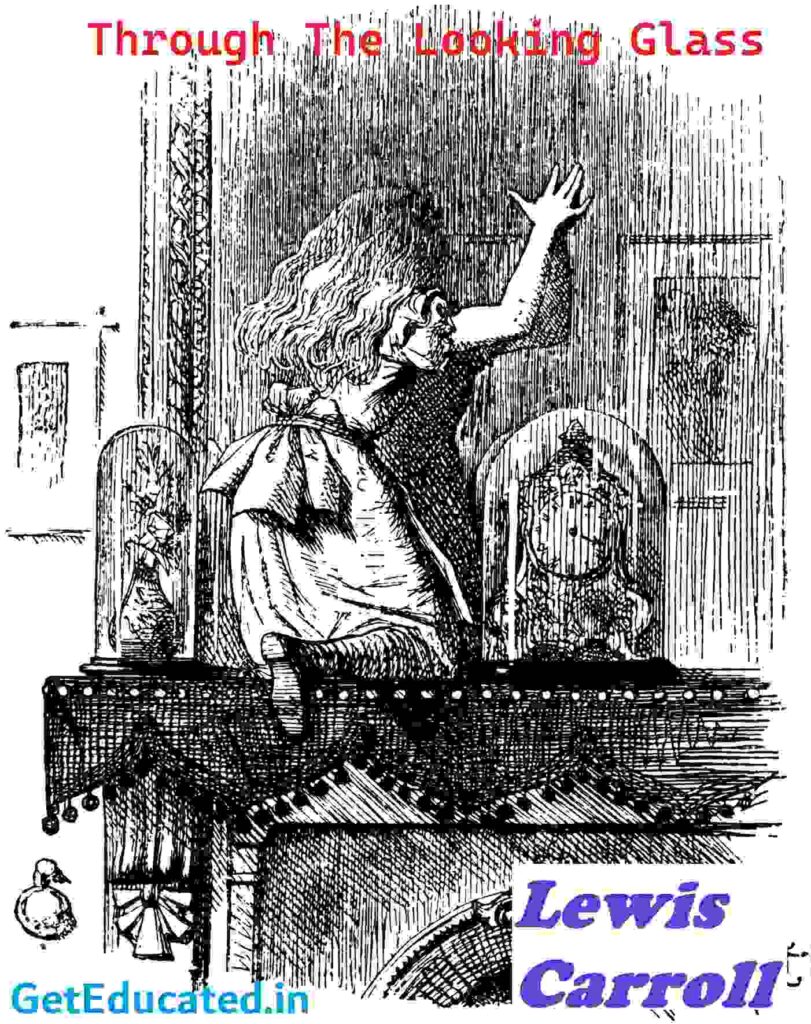
Detailed Character Analysis of Alice in Through The Looking Glass : Through the Looking-Glass and What Alice Found There, published in December 1871 (dated 1872), was written as a sequel to Alice’s Adventures in Wonderland by Lewis Carroll. Carroll first started this series as a form of communication with Alice Liddell, of whose parents he was a family friend. By the time Through the Looking-Glass was published, Alice was almost 20 years old, and Carroll’s close friendship with the Liddell family had weakened. His sequel can be seen as a fond farewell to Alice as she enters adulthood. Through the Looking-Glass follows a young Alice, six months older, on another adventure through an imaginary world. This world mirrors her own and like Wonderland is full of illogical behavior, tests, and lessons. Like its predecessor, Through the Looking-Glass introduces ideas about identity, confidence, discipline and so much more as Alice navigates this world laid out as a chessboard. Here, Alice, along with the inhabitants, are all pieces of one large game of chess, Alice’s ultimate goal becoming queen. She does succeed, but not without trial. Alice navigates this world almost effortlessly, and once awake those lessons she learned do not leave her. Her growth and maturity are what make this novel an interesting one to read as a Bildungsroman. Though Alice does not physically grow, her level of maturity develops well from start to finish.
Alice is the main character of the story “Alice’s Adventures in Wonderland” and the sequel “Through the Looking-Glass and what Alice found there”.
She is a seven-year-old English girl (in ‘Alice’s Adventures in Wonderland’ she is exactly seven years old. in “Through the Looking-Glass’ she is seven and a half) with lots of imagination and is fond of showing off her knowledge. Alice is polite, well raised and interested in others, although she sometimes makes the wrong remarks and upsets the creatures in Wonderland. She is easily put off by abruptness and rudeness of others. In Through the Looking-Glass, she is 6 months older and more sure of her identity.
In the article ‘Alice on Stage’, Carroll gives the following description of her “Loving, first, loving and gentle: loving as a dog (forgive the prosaic simile, but I know no earthy love so pure and perfect), and gentle as a fawn; then courteous – courteous to all, high or low, grand or grotesque, King or Caterpillar, even as though she were herself a King’s daughter, and her clothing of wrought gold: then trustful, ready to accept the wildest impossibilities with all that utter trust that only dreamers know; and lastly, curious-wildly curious, and with the eager enjoyment of Life that comes only in the happy hours of childhood, when all is new and fair, and when Sin and Sorrow are but names-empty words signifying nothing!”
The character of Alice is based on a real girl, called Alice Liddell, who was one of the author’s child- frends. The illustrations of Alice by John Tenniel are not based on Alice Liddell. Carroll sent Tenniel a photograph of Mary Hilton Badcock, another child-friend, who was the daughter of the Dean of Ripon. He recommended her as a model, but whether Tenniel accepted this advice remains a matter of dispute.
Alice is reasonable, well-trained, and polite. From the start, she is a miniature, middle-class Victorian “lady.” Considered in this way, she is the perfect foil, or counterpoint, or contrast, for all the unsocial, bad-mannered eccentrics whom she meets in Wonderland. Alice’s constant resource and strength is her courage. Time and again, her dignity, her directness, her conscientiousness, and her art of conversation all fail her. But when the chips are down, Alice reveals something to the Queen of Hearts- that is, spunk! Indeed, Alice has all the Victorian virtues, including a quaint capacity for rationalization; yet it is Alice’s common sense that makes the quarrelsome Wonderland creatures seem perverse in spite of what they consider to be their “adult” identities.
Certainly. Alice fits no conventional stereotype; she is neither angel nor brat. She simply has an overwhelming curiosity, but it is matched by restraint and moderation. She is balanced in other ways, too. To control her growth and shrinking, she only “samples” the cake labeled “EAT ME.” And never is there a hint that she would seek to use her size advantage to control her fate and set dictatorial rules of behavior for Wonderland. The Caterpillar takes offense when she complains of being three inches tall. And the Duchess is unreasonable, coarse, and brutal. But in each case, their veneer of “civility” is either irrational or transparent. The Caterpillar finds mirth in teasing Alice with his pointed, formal, verb games, and the rude Duchess mellows into a corrupt “set of silly rules.” Yet, behind their playfulness, Alice senses resentment and rage. It is not so much that Alice is kept “simple” so as to throw into relief the monstrous aspects of Wonderland characters. Rather, it is that Alice, as she conceives of her personality in a dream, sees herself as simple, sweet, innocent, and confused.
Some critics feel that Alice’s personality and her waking life are reflected in Wonderland; that may be the case. But the story itself is independent of Alice’s “real world.” Her personality, as it were, stands alone in the story, and it must be considered in terms of the Alice character in Wonderland.
A strong moral consciousness operates in all of Alice’s responses to Wonderland, yet on the other hand, she exhibits a child’s insensitivity in discussing her cat Dinah with the frightened Mouse in the pool of tears. Generally speaking, Alice’s simplicity owes a great deal to Victorian feminine passivity and a repressive domestication. Slowly, in stages, Alice’s reasonableness, her sense of responsibility, and her other good qualities will emerge in her journey through Wonderland and, especially, in the trial scene. Her list of virtues is long: curiosity, courage, kindness, intelligence, courtesy, humor, dignity, and a sense of justice. She is even “maternal” with the pig/baby. But her constant and universal human characteristic is simple wonder-something which all children (and the child that still lives in most adults) can easily identify with.
Unlike in Wonderland, once in the Looking-Glass world Alice adjusts quickly to her surroundings. Here she has control of herself and goes unnoticed for a while in the room. Though she is normal sized, the talking and moving chess board pieces take no notice to her. Alice remedies this quickly by writing out a message in the king’s memory book. This startles the creatures, but most importantly, it makes Alice’s presence known. After this encounter, Alice can be seen and heard this being her primary objective at the moment. Alice’s quick thinking, although disguised as childish foolery, is important to note here. She has been in this world a few minutes and her actions are much more logical than they were in Wonderland. She has full awareness and control of herself, whereas the trip to Wonderland made her question her identity. This awareness is made clear to us when Alice walks out onto the path outside of the house. She walks the path a few times expecting it to lead to the hill she sees off in the distance, instead the path always leads back to the house she just walked out of. Curious enough, Alice walks on determined to make the hill just off in the distance, she tells the house, “I’m not going in again yet. I know I should have to get through the Looking-Glass again-back into the old room-and there’d be an end of all my adventures!” (Looking- Glass 14). Alice’s commentary of the world and her place within it demonstrates how fully aware Alice is in this world and her ability to move between worlds; a stark contrast from Wonderland. She is also aware that she cannot stay in this world long, but if she is to go back that her adventures would end here with this world. Though a dream-vision like Wonderland, in this dream-vision Alice is awake rather than asleep. Her consciousness is aligned with this dream, making her experience here logical to navigate.
The end of this novel is especially interesting for our protagonist. Unlike in Wonderland, Alice does not ate leave this dream world behind, in fact she brings it with her when she wakes. As she’s waking, she espectfully, yet with some severity” tells Kitten not to purr so loud, her lessons from the Looking-Class world still very fresh on her mind. She goes on to try to start a conversation with her pet cats Kitty. Snowball, and Dinah in which she mentions that it’d be better if cats purred for “yes” or meowed for “no” so that one could keep up a conversation!” (133) she quickly counters that by asking herself “how can you talk with a person if they always say the same thing?” clearly taking note from her conversations with Humpty Dumpty and the twens Alice ties her dream world with her real one even further. As she’s talking to each cat she figures out which character from her dream the cat embodies. She settles on Kitty as the Red Queen, Snowdrop as the White Queen, and Dinah as Humpty Dumpty (134-35). The choices are interesting here because Kitty and Snowball are both the children of Dinah, who me met in Wonderland in the Looking-Glass world, though Humpty Dumpty seems to be a prestigious inhabitant, both the Red Queen and White Queen trump him in ranking. Alice’s use of Dinah’s children is reflective of her childlike mindset In the Looking-Glass world, these characters helped Alice on her journey, with Humpty being possibly wisest, it’s no surprised she’s made these correlations between the cats and characters What is even more interesting, at the end of the novel is that Alice is aware that this was her dream an imagination, but she states “now, Kitty, let’s consider who it was that dreamed it all”
Alice’s story is much different than other Bildungsroman novels. Although she does not age beyond seven in either of her stories, she learns the same lessons any other protagonist would learn over their entire lifespan. Both of Alice’s adventures have taught her important lessons on growing older and maturing Learning persistence and patience (Looking-Glass) are just as important as learning identity and confidence (Wonderland) In the Looking-Glass world, Alice lets her lessons in confidence and identity fuel her lessons in patience and persistence. Her journey is unlike in which usually characters experience these things over years in which Alice has already experienced in just a few months. Though she does not grow older, she does grow wiser. As a children’s novels these qualities are some of the most important to instill in children.
